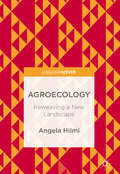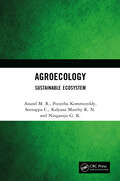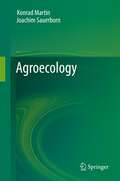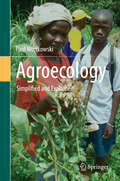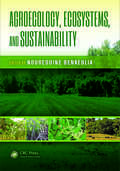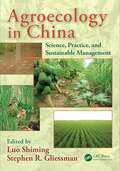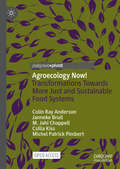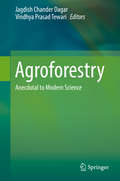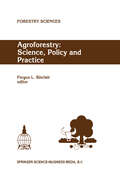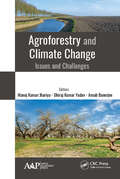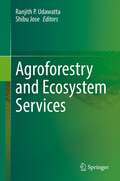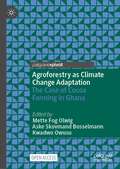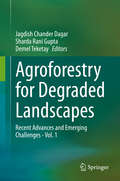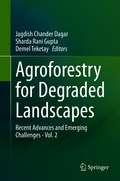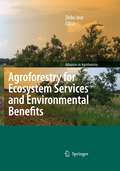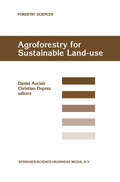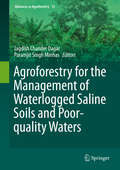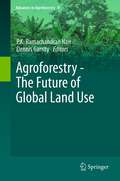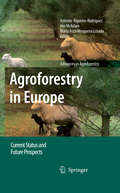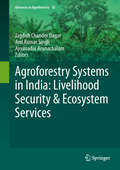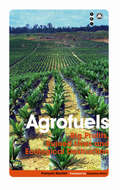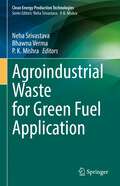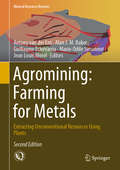- Table View
- List View
Agroecology: Reweaving a New Landscape
by Angela HilmiThis book argues that sustainable development, based on sustained growth, has led us to an impasse. In response, Agroecology brings back and utilises notions of eco-development and co-evolution with nature as a refreshing paradigm. It also proposes a further shift in mindset with the notion of being within, or looking at agroecology as a way to reconnect and rebuild relationships and movement within farming systems and beyond. Rather than linear technical fixes, it considers the critical nodes of tension, the inflection points, or acupoints, which can trigger a transition towards greater harmony and well-being. The book also draws from a concrete example of agroecology by examining a pilot project in Mozambique testing new approaches to investments and peasant farming that will inspire farming communities, researchers, policy makers and development organizations alike, to build greater autonomy and self-determination.
Agroecology: Sustainable Ecosystem
by Anand M. R. Poojitha Kommireddy Seenappa C. Kalyana Murthy K. N. Ningaraju G. K.Agroecology literacy is 'the degree to which people have an objective and well-informed understanding of crop production with environmental issues.' The increased food grain production has also increased the unscientific and indiscriminate use of agrochemicals which has affected the soil health and degraded agroecosystem adversely and brought down the immunity of soil and the productivity of crops. In addition, it has resulted in the over-exploitation of soil, leading to nutrient imbalance. Moreover, the negative impact of chemical agriculture on the environment and human health has been reported and documented. Increased environmental awareness and health consciousness promoted scientists and planners to think about sustainable farming practices as an alternate way for healthy agriculture to protect the environment and human health. Eco-friendly methods or ecosystem services are one solution to manage this issue. This book intends to provide the core elements of a curriculum for teaching agroecology at colleges and universities. Print edition not for sale in India.
Agroecology: Sustainable Ecosystem
by Anand M. R. Poojitha Kommireddy Seenappa C. Kalyana Murthy K. N. Ningaraju G. K.Agroecology literacy is 'the degree to which people have an objective and well-informed understanding of crop production with environmental issues.' The increased food grain production has also increased the unscientific and indiscriminate use of agrochemicals which has affected the soil health and degraded agroecosystem adversely and brought down the immunity of soil and the productivity of crops. In addition, it has resulted in the over-exploitation of soil, leading to nutrient imbalance. Moreover, the negative impact of chemical agriculture on the environment and human health has been reported and documented. Increased environmental awareness and health consciousness promoted scientists and planners to think about sustainable farming practices as an alternate way for healthy agriculture to protect the environment and human health. Eco-friendly methods or ecosystem services are one solution to manage this issue. This book intends to provide the core elements of a curriculum for teaching agroecology at colleges and universities. Print edition not for sale in India.
Agroecology
by Konrad Martin Joachim SauerbornThis book represents an interdisciplinary approach to the relevant aspects of agricultural production related to the interactions between natural processes, human activities and the environment. It provides condensed and comprehensive knowledge on the functions of various agroecosystems at the field, landscape and global scale. Understanding and integrating complex ecological processes into field production, land management and food systems is essential in order to deal with the challenges of modern crop and livestock production: the need for food security for the growing human population, and the necessity to combat the detrimental effects of food production on the environment. The book provides the scientific basis required by students and scientists involved in the development of sustainable agroecosystems and contributes to a range of disciplines including Agriculture, Biology, Geography, Landscape Ecology, Organic Farming, Biological Control, and Global Change Ecology.
Agroecology: Simplified and Explained
by Paul WojtkowskiThis book presents the core elements that underwrite agroecology. Expressed across twelve chapters, the universality of the core is the essence of agroecology. This alone would be of interest to researchers, students, and academics. Furthermore, the book contains a long, detailed, and inclusive glossary that, with over 160 entries, elaborates on the topics presented. Included are recent developments as well as time-tested, traditional farm practices. The book also advances the theoretical base, fills gaps in the published research, and suggests future opportunities and future directions. The book is internationally oriented, presenting both temperate and tropical agriculture. The book begins by comparing agroecology against conventional, monoculturally-based agriculture. In doing so, it defines the unique features of agroecology and their significance in achieving sustainable and environmentally-friendly agriculture. The book goes on to discuss the underlying technologies, the various manifestations of biodiversity, and the risk countermeasures associated with agroecology. This includes the farm landscape as a positive base for ecology, and how, if used well, it can produce major economic growth. The book concludes by summarizing the key findings, and assessing the macro-challenges facing agroecology.
Agroecology, Ecosystems, and Sustainability
by Noureddine BenkebliaWe hear a lot about how agriculture affects climate change and other environmental issues, but we hear little about how these issues affect agriculture. When we look at both sides of the issues, we can develop better solutions for sustainable agriculture without adversely affecting the environment. Agroecology, Ecosystems, and Sustainability explor
Agroecology in China: Science, Practice, and Sustainable Management (Advances in Agroecology #22)
by Stephen R. Gliessman Luo ShimingKey features: Reviews the development of agroecology in China, including research, practice, management, and education regarding challenges for rural and agricultural progress Presents information from sources not readily available in the West about agricultural development in China during the last several decades Provides models and indicates starting points for future research and practice Addresses how to meet future challenges of agroecosystems from the field to the table in China from scientific, technological, and management perspectives During the past 30 years, industrialization has fundamentally changed traditional rural life and agricultural practices in China. While the incomes of farmers have increased, serious issues have been raised concerning the environment, resource depletion, and food safety. In response, the Chinese government and Chinese scientists encouraged eco-agriculture, the practice of agroecology principles and philosophy, as a way to reduce the negative consequences of large-scale industrialized systems of farming. Agroecology in China: Science, Practice, and Sustainable Management represents the work of experts and leaders who have taught, researched, and expanded Chinese agroecology and eco-agriculture for more than 30 years. It reviews decades of agricultural change to provide an integrated analysis of the progress of research and development in agroecological farming practices. The book contains research on traditional and newly developed agricultural systems in China, including intercropping systems, rainfall harvest systems, and rice–duck, rice–fish, and rice–frog co-culture systems. It covers current eco-agriculture practices in the major regions of China according to climate conditions. The book closes with a discussion of the major technical approaches, necessary policy support, and possible major development stages that must occur to allow broader agroecological implementations toward the sustainability of future food systems in China. Presenting eco-agriculture systems that are somewhat unique in comparison to those of the United States, Latin America, and Europe, Agroecology in China gives insight on how Chinese agroecologists, under the political and cultural systems specific to China, have created a strong foundation for ecologically sound agroecosystem design and management that can be applied and adapted to food systems elsewhere in the world. By using selected regional examinations of agroecological efforts in China as examples, this book provides models of how to conduct research on a broad range of agroecosystems found worldwide.
Agroecology Now!: Transformations Towards More Just and Sustainable Food Systems
by Colin Ray Anderson Janneke Bruil M. Jahi Chappell Csilla Kiss Michel Patrick PimbertThis open access book develops a framework for advancing agroecology transformations focusing on power, politics and governance. It explores the potential of agroecology as a sustainable and socially just alternative to today’s dominant food regime. Agroecology is an ecological approach to farming that addresses climate change and biodiversity loss while contributing to the Sustainable Development Goals. Agroecology transformations represent a challenge to the power of corporations in controlling food system and a rejection of the industrial food systems that are at the root of many social and ecological ills. In this book the authors analyse the conditions that enable and disable agroecology’s potential and present six ‘domains of transformation’ where it comes into conflict with the dominant food system. They argue that food sovereignty, community-self organization and a shift to bottom-up governance are critical for the transformation to a socially just and ecologically viable food system. This book will be a valuable resource to researchers, students, policy makers and professionals across multidisciplinary areas including in the fields of food politics, international development, sustainability and resilience.
Agroforestry: Anecdotal to Modern Science (Advances In Agroforestry Ser. #10)
by Jagdish Chander Dagar Vindhya Prasad TewariAgroforestry (AF) is a dynamic, ecologically based, natural resources management system that, by integrating trees on farms, ranches, and in other landscapes, diversifies and increases production and promotes social, economic, and environmental benefits for land users. Further, it is receiving increasing attention as a sustainable land-management option worldwide because of its ecological, economic, and social attributes. Advances have been achieved by building on past research accomplishments and expanding AF’s stakeholder base, which now includes private/public partnerships, communities, ecologists, farmers, indigenous peoples, and policymakers in both temperate and tropical countries.AF has now been recognized as a valuable problem-solving approach to ensuring food security and rebuilding resilient rural environments. Recent studies have shown that more than 1 billion hectares of agricultural land have more than 10% tree cover. Of this area, 160 million hectares have more than 50% tree cover. Agricultural ecosystems can be further improved through AF to achieve environmental restoration, greater farm productivity, and key ecological services, including climate change mitigation and adaptation for improved rural livelihood. In fact, it is largely considered synonymous with climate smart agriculture and a remedy for many modern environmental challenges. Consequently, AF’s knowledge base is being expanded at a rapid rate, as illustrated by the increasing number and quality of scientific publications on various forms and different aspects of AF.This book offers state-of-the-art information on the fundamental concepts and history of AF and its evolution as a science, presenting a wealth of advanced research results and evaluations relating to different aspects of AF. Accordingly, it will be useful for a broad readership, including students, foresters, farmers, local communities, indigenous peoples, civil society institutions, media, policymakers and the general public.
Agroforestry: Selected papers from the agroforestry sessions of the IUFRO 20th World Congress, Tampere, Finland, 6–12 August 1995 (Forestry Sciences #47)
by Fergus L. SinclairAgroforestry research is central to developing methods for the sustainable use of natural renewable resources, evolving to address the needs of the coming century. It is now necessary to consolidate the scientific gains now being made in process-oriented research and to develop a policy framework to encourage the adoption of sustainable land use practices. Agroforestry plays an important role in conserving forest resources, reducing the need for deforestation. Further, if `forest' is broadly defined as tree cover, agroforestry will also increase the proportion of woody biomass in farming landscapes. The papers selected for inclusion in Agroforestry: Science, Policy, and Practice establish agroforestry as an interdisciplinary science focused on the practical imperative of assisting farmers, forest dwellers and landscape-level planners to achieve sustainable food, fuel and timber production into the 21st century.
Agroforestry and Climate Change: Issues and Challenges
by Manoj Kumar Jhariya Arnab Banerjee Dhiraj Kumar YadavThis volume provides an abundance of valuable information on emerging eco-friendly technology and its potential role in combating climate change via agroforesty. The volume begins by describing the recent understanding of the scenario of climate change and its issues and challenges and provides an in-depth analysis of the potential of agroforestry toward climate change mitigation and adaptation. Chapters address a wide range of techniques and methods for mitigating the negative aspects of climate change through agroforesty, such as vermicomposting, carbon sequestration, horticulture techniques, nutrient sequestration and soil sustainability, conservation of medicinal plant resources, silvipastoral systems, phytoremediation techniques, and more. The book also looks at livelihood security and the role of agroforestry. Key features: Provides updated information and recent developments in the field of climate change and agroforestry Looks at a variety of eco-friendly methods being employed to help mitigate climate change through agroforesty Provides recommendations and suggestions to build harmony between agroforestry and climate change Discusses new insights on the role of agroforestry toward combating climate change as well as maintaining the sustainability of ecosystems
Agroforestry and Climate Change: Issues and Challenges
by Manoj Kumar Jhariya Arnab Banerjee Dhiraj Kumar YadavThis volume provides an abundance of valuable information on emerging eco-friendly technology and its potential role in combating climate change via agroforesty. The volume begins by describing the recent understanding of the scenario of climate change and its issues and challenges and provides an in-depth analysis of the potential of agroforestry toward climate change mitigation and adaptation. Chapters address a wide range of techniques and methods for mitigating the negative aspects of climate change through agroforesty, such as vermicomposting, carbon sequestration, horticulture techniques, nutrient sequestration and soil sustainability, conservation of medicinal plant resources, silvipastoral systems, phytoremediation techniques, and more. The book also looks at livelihood security and the role of agroforestry. Key features: Provides updated information and recent developments in the field of climate change and agroforestry Looks at a variety of eco-friendly methods being employed to help mitigate climate change through agroforesty Provides recommendations and suggestions to build harmony between agroforestry and climate change Discusses new insights on the role of agroforestry toward combating climate change as well as maintaining the sustainability of ecosystems
Agroforestry and Ecosystem Services
by Shibu Jose Ranjith P. UdawattaThis book is a state-of-the-art compilation of the latest information on ecosystem services of agroforestry. The last two decades have seen a surge in literature on the ecosystem services of sustainable agriculture practices, including that of agroforestry; however, compilation and synthesis of such information from agroforestry have been limited. This book fills that void by bringing in a number of experts from around the world. In addition to presenting the multiple dimensions of ecosystem services provided by major agroforestry practices, the book also offers case studies from both tropical and temperate regions of the world.Information from this book can be used to design land management practices for climate change mitigation, ecosystem benefits, agricultural productivity and sustainability, and for survival and profitability of family farms and to conserve biodiversity. While synthesizing information of the biophysical aspects of ecosystem services, the book also outlines the socioeconomic and policy dimensions, including appropriate incentive models to enhance adoption of agroforestry so that society at large can enjoy these important benefits
Agroforestry as Climate Change Adaptation: The Case of Cocoa Farming in Ghana
by Mette Fog Olwig Aske Skovmand Bosselmann Kwadwo OwusuThis open access book provides multidisciplinary perspectives on the potential of agroforestry to mitigate the negative impacts of climate change on cocoa production. Against the backdrop of increasingly precarious farmer livelihoods, it focuses on cocoa-agroforestry in Ghana – the second largest producer of cocoa in the world. Taking the reader on a journey across experimental plots and on-farm studies, the book delivers a holistic understanding of cocoa-agroforestry. Chapters examine historical yield and climate interactions, the effects of heat and drought on cocoa plants and the role of differing shade trees on soil fertility, yields, pests and diseases. The book discusses the socioeconomics of shade tree management, including cost-benefits, tree rights and competition for natural resources emphasizing policy implications and recommendations.Taking a multidisciplinary approach to climate-agriculture interactions, the book provides an innovative understanding of agroforestry and perennial cropping systems that goes beyond the Ghanaian cocoa belt. It is of relevance to students, researchers, farmers, practitioners and policymakers working with agroforestry and climate change adaptation.This is an open access book.
Agroforestry for Degraded Landscapes: Recent Advances and Emerging Challenges - Vol.1
by Jagdish Chander Dagar Sharda Rani Gupta Demel TeketayThis book presents various aspects of agroforestry research and development, as well as the latest trends in degraded landscape management. Over the last four decades, agroforestry research (particularly on degraded landscapes) has evolved into an essential problem-solving science, e.g. in terms of sustaining agricultural productivity, improving soil health and biodiversity, enhancing ecosystem services, supporting carbon sequestration and mitigating climate change. This book examines temperate and tropical agroforestry systems around the world, focusing on traditional and modern practices and technologies used to rehabilitate degraded lands. It covers the latest research advances, trends and challenges in the utilization and reclamation of degraded lands, e.g. urban and peri-urban agroforestry, reclamation of degraded landscapes, tree-based multi-enterprise agriculture, domestication of high-value halophytes, afforestation of coastal areas, preserving mangroves and much more. Given its scope, the book offers a valuable asset for a broad range of stakeholders including farmers, scientists, researchers, educators, students, development/extension agents, environmentalists, policy/decision makers, and government and non-government organizations.
Agroforestry for Degraded Landscapes: Recent Advances and Emerging Challenges - Vol. 2
by Jagdish Chander Dagar Sharda Rani Gupta Demel TeketayThis book presents various aspects of agroforestry research and development, as well as the latest trends in degraded landscape management. Over the last four decades, agroforestry research (particularly on degraded landscapes) has evolved into an essential problem-solving science, e.g. in terms of sustaining agricultural productivity, improving soil health and biodiversity, enhancing ecosystem services, supporting carbon sequestration and mitigating climate change. This book examines temperate and tropical agroforestry systems around the world, focusing on traditional and modern practices and technologies used to rehabilitate degraded lands. It covers the latest research advances, trends and challenges in the utilization and reclamation of degraded lands, e.g. urban and peri-urban agroforestry, reclamation of degraded landscapes, tree-based multi-enterprise agriculture, domestication of high-value halophytes, afforestation of coastal areas, preserving mangroves and much more. Given its scope, the book offers a valuable asset for a broad range of stakeholders including farmers, scientists, researchers, educators, students, development/extension agents, environmentalists, policy/decision makers, and government and non-government organizations.
Agroforestry for Ecosystem Services and Environmental Benefits (Advances in Agroforestry #7)
by Shibu Jose Springer Firm StaffAgroforestry systems are believed to provide a number of ecosystem services; however, until recently evidence in the agroforestry literature supporting these perceived benefits has been lacking. This volume brings together a series of papers from around the globe to address recent findings on the ecosystem services and environmental benefits provided by agroforestry. Specifically, this volume examines four major ecosystem services and environmental benefits: (1) carbon sequestration, (2) biodiversity conservation, (3) soil enrichment and (4) air and water quality. Past and present evidence clearly indicates that agroforestry, as part of a multifunctional working landscape, can be a viable land-use option that, in addition to alleviating poverty, offers a number of ecosystem services and environmental benefits. This realization should help promote agroforestry and its role as an integral part of a multifunctional working landscape the world over. The book should be particularly useful to students, professionals, researchers and policy makers involved in natural resource management, agroforestry, biodiversity conservation, and environmental management. Reprinted from Agroforestry Systems, Volume 76, No. 1 (2009)
Agroforestry for Sustainable Land-Use Fundamental Research and Modelling with Emphasis on Temperate and Mediterranean Applications: Selected papers from a workshop held in Montpellier, France, 23–29 June 1997 (Forestry Sciences #60)
by Daniel Auclair C. DuprazThis volume comprises a selection of original contributions presented at a workshop held in Montpellier, France, in June 1997. The two main objectives of the workshop were, firstly, to bring together what is understood about the processes underlying agroforestry practice, and, secondly, to provide a forum to explore relevant models and modelling approaches. The workshop was also able to play a role in examining the agroforestry systems encountered in temperate and Mediterranean areas, including both traditional and more innovative agroforestry practices. The main aspects discussed were: ecological interactions amongst components, environmental impact, economics and policy modelling.
Agroforestry for the Management of Waterlogged Saline Soils and Poor-Quality Waters (Advances in Agroforestry #13)
by Jagdish Chander Dagar Paramjit Singh MinhasLand degradation caused by salinity and waterlogging is a global problem afflicting about one billion hectares and endangering the food security of at least 75 countries. Since the social, economic and environmental costs of on and/off-farm reclamation techniques are high, agroforestry is now emerging as a potential tool, not only for arresting salinity and waterlogging, but also for other environmental services like mitigating climate change, sequestering carbon and restoring biodiversity. This publication addresses the vital issues, principles and practices related to rehabilitation using agroforestry and includes many site-specific case studies from a number of the world’s typical catchments. Written by leading researchers, the book is a must, not only for scientists whose research interests lie in soil salinity, waterlogging and poor-quality waters, but also policy makers, environmentalists, students, and educationists alike. More importantly, it contributes to reversing the salinity trends and ensuring the livelihoods of resource-poor farming families living in these harsh agro-ecosystems.
Agroforestry - The Future of Global Land Use (Advances in Agroforestry #9)
by P.K. Ramachandran Nair and Dennis GarrityThis volume contains a solid body of the current state of knowledge on the various themes and activities in agroforestry worldwide. It is organized into three sections: the Introduction section consists of the summaries of six keynote speeches at the 2nd World Congress of Agroforestry held in Nairobi, Kenya, in 2009; that is followed by two sections of peer-reviewed thematic chapters grouped as “Global Perspectives” (seven chapters) and “Regional Perspectives” (eleven chapters), authored by professional leaders in their respective agroforestry-related fields worldwide. A total of 130 professionals from institutions in 33 countries in both developing and the industrialized temperate regions of the world contributed to the book as chapter authors and/or reviewers. Thus, the book presents a comprehensive and authoritative account of the global picture of agroforestry today.
Agroforestry in Europe: Current Status and Future Prospects (Advances in Agroforestry #6)
by Antonio Rigueiro-Rodríguez Jim McAdam María Rosa Mosquera-LosadaAgroforestry has come of age during the past three decades. The age-old practice of growing trees and crops and sometimes animals in interacting combinations – that has been ignored in the single-commodity-oriented agricultural and forestry development paradigms – has been brought into the realm of modern land-use. Today agroforestry is well on its way to becoming a specialized science at a level similar to those of crop science and forestry science. To most land-use experts, however, agroforestry has a tropical connotation. They consider agroforestry as something that can and can only be identified with the tropics. That is a wrong perception. While it is true that the tropics, compared to the temperate regions, have a wider array of agroforestry systems and hold greater promise for potential agroforestry interventions, it is also true that agroforestry has several opportunities in the temperate regions too. Indeed, the role of agroforestry is now recognized in Europe as exemplified by this book, North America, and elsewhere in the temperate zone. Current interest in ecosystem management in industrialized countries strongly suggests that there is a need to embrace and apply agroforestry principles to help mitigate the environmental problems caused or exacerbated by commercial agricultural and forestry production enterprises.
Agroforestry Systems in India: Livelihood Security And Ecosystem Services (Advances in Agroforestry #10)
by Jagdish Chander Dagar Anil Kumar Singh Ayyanadar ArunachalamAgroforestry, the word coined in early seventies, has made its place in all the developed and the developing countries of the world and is now recognized as an important approach to ensuring food security and rebuilding resilient rural environments. India has been an all-time leader in agroforestry. The South and Southeast Asia region comprising India is often described as the cradle of agroforestry. Almost all forms of agroforestry systems exist across India in ecozones ranging from humid tropical lowlands to high-altitude and temperate biomes, and perhumid rainforest zones to parched drylands. The country ranks foremost among the community of nations not only in terms of this enormous diversity and long tradition of the practice of agroforestry, but also in fostering scientific developments in the subject. Agroforestry applies to private agricultural and forest lands and communities that also include highly erodible, flood-prone, economically marginal and environmentally sensitive lands. The typical situation is agricultural, where trees are added to create desired benefits. Agroforestry allows for the diversification of farm activities and makes better use of environmental resources. Owing to an increase in the population of human and cattle, there is increasing demand of food as well as fodder, particularly in developing countries like India. So far, there is no policy that deals with specifics in agroforestry in India. But, the Indian Council of Agricultural Research has been discussing on the scope of having a National Agroforestry Policy in appropriate platforms. However, evolving a policy requires good and reliable datasets from different corners of the country on the subject matter. This synthesis volume containing 13 chapters is an attempt to collate available information in a classified manner into different system ecologies, problems and solutions, and converging them into a policy support.
Agrofuels: Big Profits, Ruined Lives and Ecological Destruction (Transnational Institute)
by François HoutartAgrofuels were heralded as a key weapon in the fight against climate change, but the deforestation and theft of agricultural land that was essential to farmers in the developing world, suggests that they are doing more harm than good.*BR**BR*Francois Houtart argues that the green potential of agrofuels has been hijacked by businesses that put profits above environmental protection. This has led to the absurd situation where an energy source that should be sustainable actually increases human and ecological damage, simply due to the profit-maximising decisions of capitalists rather than a flaw in the concept of agrofuels.*BR**BR*Houtart reveals that we need to rethink neoliberalism's relationship to green politics and ask is capitalism compatible with climate change, or do we need to overhaul our economic system in order to save the planet?
Agroindustrial Waste for Green Fuel Application (Clean Energy Production Technologies)
by Neha Srivastava Bhawna Verma P. K. MishraThe book revisit in depth scope of agroindustrial waste for enhancement in biofuels production on practical ground. It explores and discusses various cellulose rich agro-wastes along with low cost, advance technology based options for sustainable biofuels production. Lignocellulosic biomasses are potential producer of biofuels due to renewable nature and huge occurrence. Cellulose is the main polymeric component of these biomasses apart from lignin and hemicellulose. It can be converted into fermentable sugars using cellulase enzyme which can be further converted into the renewable energy sources such as biohydrogen, bioethanol, biogas and butanol. Chapters in this title provide exclusive and critical analysis of specific biofuels production process only from lignocellulosic biomass, based on their type, property, availability, cost and most important sugar or cellulose content along with the simplest process search for converting these biomasses into biofuels to make overall process more simple and economical.It is a useful guide for academician and environmentalist who are working to explore feasible advantages associated with these kinds of waste management and their effective valorization. It is also a great resource for senior undergraduate and graduate students, researchers, professionals, and other interested individuals/groups working in the field of biofuel/bioenergy.
Agromining: Extracting Unconventional Resources Using Plants (Mineral Resource Reviews)
by Antony van der Ent Alan J. M. Baker Guillaume Echevarria Marie-Odile Simonnot Jean Louis MorelThis second and expanded edition of the first book on agromining (phytomining) presents a comprehensive overview of the metal farming & recovery of the agromining production chain. Agromining is an emerging technology that aims to transform the extraction of sources of target elements not accessible by traditional mining and processing techniques. Agromining, which is based on sustainable development, uses hyperaccumulator plants as 'metal crops' farmed on sub-economic soils or minerals wastes to obtain valuable target elements. This volume is edited and authored by the pioneers in the rapidly expanding field of agromining and presents the latest insights and developments in the field. This book provides in-depth information on the global distribution and ecology of hyperaccumulator plants, their biogeochemical pathways, the influence of rhizosphere microbes, the physiology and molecular biology of hyperaccumulation, as well as aspects of propagation and conservation of these unusual plants. It describes the agronomy of metal crops and opportunities for incorporating agromining into rehabilitation and mine closure, including test cases for agromining of nickel, cobalt, manganese, arsenic, selenium, cadmium, zinc, thallium, rare earth elements and platinum group elements. Since the first edition was published, there have successful nickel agromining field trials in the tropics (in Malaysia and Guatemala), and these are presented in a dedicated case study chapter. Other new chapters focus on the processing of bio-ore for elements other than nickel, such as rare earth elements and cadmium, and on agromining from industrial wastes such as tailings, and industrial by-products and sites. Furthermore, the book features two new chapters that provide a comprehensive assessment of accumulation a very wide range elements from the Periodic Table in various plant species around the globe, and a chapter on practical methods for discovery of hyperaccumulator plant species in the field and in the herbarium. This book is of interest to environmental professionals in the minerals industry, government regulators, and academics.
